 When my GG Grandfather Michael Casey was born in 1850, his father Michael was a tenant farmer working land rented from the Barrington Estate. About 70 years later, after their only daughter was killed in an IRA ambush, the Barrington’s sold their estate to the Benedictine monks who continue to run the estate today as Glenstal Abbey. And after breakfast on Friday morning, we took a nice stroll on the Abbey’s grounds, taking a quick look at the castle and meeting some Donkey’s along the way. Was the stone watchman in the castle tower there 150 years ago, watching my Casey ancestors harvest potatoes? I wonder.
When my GG Grandfather Michael Casey was born in 1850, his father Michael was a tenant farmer working land rented from the Barrington Estate. About 70 years later, after their only daughter was killed in an IRA ambush, the Barrington’s sold their estate to the Benedictine monks who continue to run the estate today as Glenstal Abbey. And after breakfast on Friday morning, we took a nice stroll on the Abbey’s grounds, taking a quick look at the castle and meeting some Donkey’s along the way. Was the stone watchman in the castle tower there 150 years ago, watching my Casey ancestors harvest potatoes? I wonder.
Next we headed into Limerick, and despite hitting some traffic heading into town, and getting turned around a bit, we ultimately succeeded in getting the car parked so we could do some shopping, which we did. I failed in my mission to dunk a friend’s hat into the Shannon River, sorry Bobby, the banks were too high.
 After our short stop in Limerick, we returned to Murroe to keep our date with Father Ryan. We met him at the church and then followed him to the Annagh Graveyard. The church in the center of the graveyard has been a ruin for more than 100 years according to the land valuation map I obtained in Dublin to locate the Casey plot, but the cemetery is still in use and has recent burials in it. Among the older markers, there were many so worn or damaged that there was nothing legible on them, and having found no Caseys among any that could be read, we had to assume that we may be close but would never know for certain if this was Michael Casey’s final resting place or not. Father Ryan returned to the church, having been very generous with his time this Easter eve, and we stayed a bit longer taking pictures in the graveyard, and then along the nearby road of what we guessed must have been the Casey plot of farmland. And our family hunt might well have ended there.
After our short stop in Limerick, we returned to Murroe to keep our date with Father Ryan. We met him at the church and then followed him to the Annagh Graveyard. The church in the center of the graveyard has been a ruin for more than 100 years according to the land valuation map I obtained in Dublin to locate the Casey plot, but the cemetery is still in use and has recent burials in it. Among the older markers, there were many so worn or damaged that there was nothing legible on them, and having found no Caseys among any that could be read, we had to assume that we may be close but would never know for certain if this was Michael Casey’s final resting place or not. Father Ryan returned to the church, having been very generous with his time this Easter eve, and we stayed a bit longer taking pictures in the graveyard, and then along the nearby road of what we guessed must have been the Casey plot of farmland. And our family hunt might well have ended there.
But it did not.
At Ryan’s pub in nearby Newport, I asked the woman tending bar if there were any Casey’s in the area. She said she wasn’t from nearby, but would ask the owner, and shortly he came by to speak with us. When I asked him about Casey’s, he paused for a bit and then told me to follow him outside into the street. Pointing up the street at a house a few hundred yards away he said, “Willie Casey lives there, you should talk to him.” And so we finished our drinks, which they wouldn’t let us pay for, and we set off to find Willie.
The woman who answered my knock at the door was quick to welcome us in when I mentioned my name was Casey and I was hoping to speak with Willie. And in no time we were sitting at the kitchen table with Willie and his wife Maureen, comparing Casey notes. Soon Maureen had me on the phone with Willie’s cousin, and while we didn’t find any direct connection between ourselves, they knew of other nearby Caseys and mentioned another neighbor we should speak took, and a graveyard we should visit called Ballymackeogh. A few doors down, we dropped in on Mary Ryan, and after a quick explanation we again received a warm welcome. Mary’s aunt was married to a Michael Casey, and when Mary confirmed that this Michael’s father had been named Thomas, and that they had farmed land in Annagh across the county line, the pieces all seemed to fit to say this Michael was my first cousin, three times removed (or more easily, my GG Grandfather’s nephew, I couldn’t sort any of these complex relationships out without my computer!). Mary gave us directions to another local cemetery, Rockvale, in which she said Michael had been the first burial. When we asked for directions, Mary pointed and said, “It’s just that way across the fields. But by car you’ll need to turn right at the main street in town and follow your noses from there”. That worked, and at Rockvale Cemetery we located my distant cousin Michael Casey, and a number of other Casey’s which we have yet to sort out. I should say ‘Jennifer located’, because she was always first to find the headstones we were seeking.
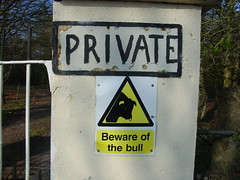 Finding Ballymackeogh was a bit more difficult, but after a few tries we found ourselves at then end of a gravel road facing a locked gate with three signs nearby. The first read ‘Ballymackeogh Graveyard’, the second essentially said ‘Private Property, Keep Out’, and the third read ‘Beware of the bull’. It was the third sign that most caught our notice. But having traveled so far, and now standing outside the gate that I thought could lead to my ancestors graves, was I to let a bull stop us? Never! I went first into the field, with Jennifer bravely following about 25 yards behind (wearing her new bullfighting red sweater), and our caution was rewarded by our arrival at the graveyard gates about 100 yards across the pasture, with no bull anywhere in sight.
Finding Ballymackeogh was a bit more difficult, but after a few tries we found ourselves at then end of a gravel road facing a locked gate with three signs nearby. The first read ‘Ballymackeogh Graveyard’, the second essentially said ‘Private Property, Keep Out’, and the third read ‘Beware of the bull’. It was the third sign that most caught our notice. But having traveled so far, and now standing outside the gate that I thought could lead to my ancestors graves, was I to let a bull stop us? Never! I went first into the field, with Jennifer bravely following about 25 yards behind (wearing her new bullfighting red sweater), and our caution was rewarded by our arrival at the graveyard gates about 100 yards across the pasture, with no bull anywhere in sight.
Ballymackeogh was similar to the other graveyards that we had visited in that it had a roofless, ivy-covered church ruin the in middle, but was different in that the grounds around the ruin we terraced with paths, and the ground much more uneven. Headstones jutted out of the ground at every angle, some laying flat on the ground and others in broken piles. In placed the ground had collapsed in on a grave, while in others the grave was a large mound pushing upwards. It was late afternoon by this point, and long shadows hung everywhere. It was a very peaceful place, and as graveyards go, could be a scary one.
Once again, Jennifer found the Casey’s. A plot of four graves near one of the church corners had four burials, one of which seems to match well with our hunt. Reading with our fingers, we found a headstone that read:
Erected by Thomas Casey in memory of his Father Michael Casey of Polough who died Oct 9 1884, aged 70 years. May his soul rest in peace.
The death certificate for my GGG Grandfather Michael Casey says he died on 12/1/1882 at age 66, a pretty big difference from this headstone which is specific enough to give confidence in its facts. So do I have the right Michael Casey and just some errors of fact over time? Or are there two Michael Caseys, with sons named Thomas, who lived, farmed and died at about the same time in very close proximity? I don’t know. Progress brings new questions, that’s just how it goes in genealogy. Wherever the truth is, the hunt continues.
We made it back through the pasture without any sign of the bull, and headed to Bunratty hoping to get in on one of their Castle Banquets for our last night’s meal, but finding it booked we had a very fine meal at a nearby restaurant and headed back to our B&B for our last night’s sleep in Ireland.
Like this:
Like Loading...
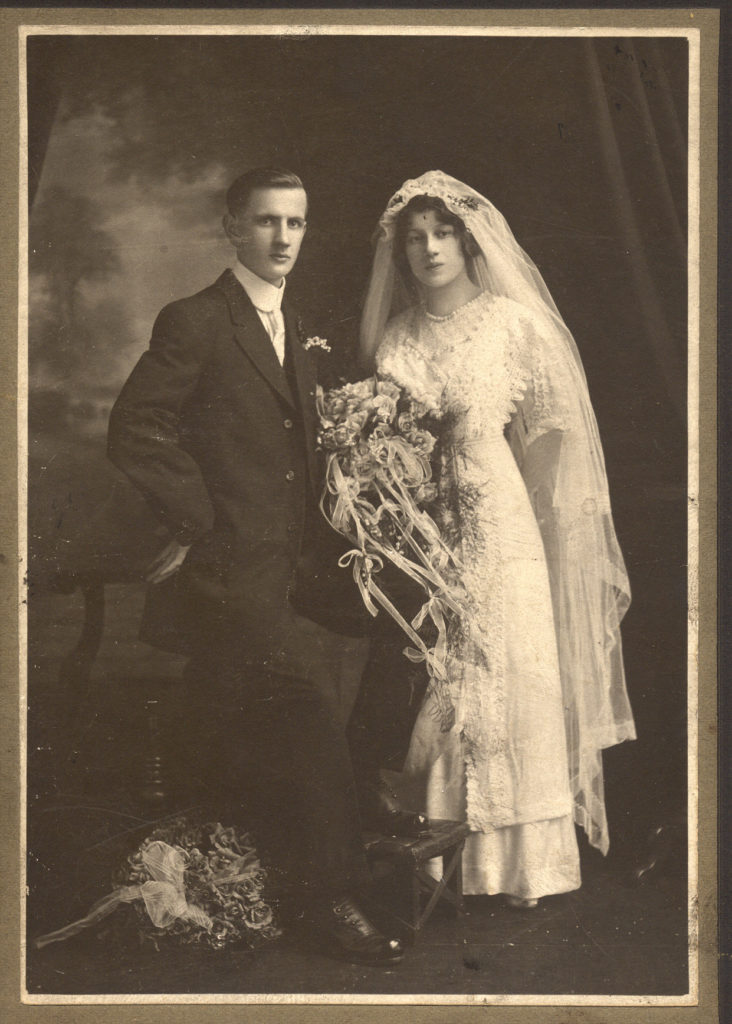



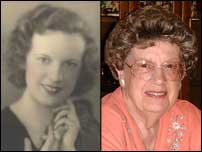 Today is my grandmother’s birthday. She would have been 95 years old, but sadly did not reach that milestone having passed away two months ago. She was the oldest of five children of
Today is my grandmother’s birthday. She would have been 95 years old, but sadly did not reach that milestone having passed away two months ago. She was the oldest of five children of 
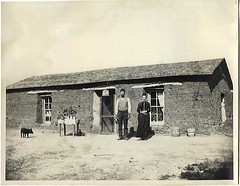




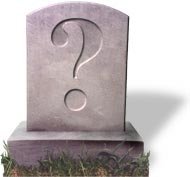
 Ninety-five years ago, in 1910, seven of the eight individuals who would eventually become my Great Grandparents were living in Chicago. The eighth, arrived in 1911. I’m going to attempt to write about their lives and circumstances at the time, not from first-hand knowledge, but by blending information available and familiar to any genealogist; public records, family histories, and the recollections of their children and others who knew them. And the first couple that I will write about, is Victor and Rose.
Ninety-five years ago, in 1910, seven of the eight individuals who would eventually become my Great Grandparents were living in Chicago. The eighth, arrived in 1911. I’m going to attempt to write about their lives and circumstances at the time, not from first-hand knowledge, but by blending information available and familiar to any genealogist; public records, family histories, and the recollections of their children and others who knew them. And the first couple that I will write about, is Victor and Rose. Like Victor, Rose Bicek was also the youngest child in a large family. Her parents, Martin and Marie had immigrated from Bohemia in 1883, bringing their two oldest children Marie and James with them. Rose was the last of four more daughters who were all born in Chicago. Martin had worked as a day laborer and teamster, and in 1910 at age 58 he worked as a watchman in a coal yard. Three daughters still lived with Martin and Marie in the home at 2818 Clifton Park Avenue (later renamed to Drake Ave). Sister Emma, married to Alfred Sengstock, a Wells Fargo clerk, lived there with their two-month old daughter Adeline. Bessie and Rose also lived at home when the Census taker visited their home in June of 1910. Rose had turned 17 in January, and both Rose and Bessie worked as servers at a “WholesaleN”?
Like Victor, Rose Bicek was also the youngest child in a large family. Her parents, Martin and Marie had immigrated from Bohemia in 1883, bringing their two oldest children Marie and James with them. Rose was the last of four more daughters who were all born in Chicago. Martin had worked as a day laborer and teamster, and in 1910 at age 58 he worked as a watchman in a coal yard. Three daughters still lived with Martin and Marie in the home at 2818 Clifton Park Avenue (later renamed to Drake Ave). Sister Emma, married to Alfred Sengstock, a Wells Fargo clerk, lived there with their two-month old daughter Adeline. Bessie and Rose also lived at home when the Census taker visited their home in June of 1910. Rose had turned 17 in January, and both Rose and Bessie worked as servers at a “WholesaleN”?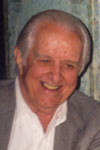 Tonight my Casey searching took me to Genealogy.com’s
Tonight my Casey searching took me to Genealogy.com’s